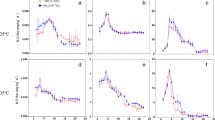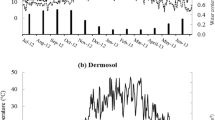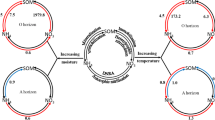Abstract
Purpose
The responses of N2O emission to increasing temperature in different soil horizons are not clearly understood yet. Here, we investigated the effects of increasing temperature on sources of soil N2O emissions from organic (O) and mineral (A) horizons of a temperate forest soil.
Materials and methods
An incubation experiment using 15N as a tracer was conducted to investigate the sources of soil N2O emission and their responses to increasing temperature in the O and A horizon soils at controlled temperatures (5 °C, 15 °C, 25 °C, and 35 °C at 60% water holding capacity). The O horizon had higher total organic carbon, total nitrogen, and sand contents than the A horizon.
Results and discussion
The ratio of nitrification- to denitrification-derived N2O production decreased with increasing temperature in both soil horizons, perhaps due to the development of anaerobic volumes and the greater increase in nirS gene abundance. The nirS gene was much more abundant than the nirK gene and was more correlated to denitrification-derived N2O flux. No relationship was found between nitrification-derived N2O flux and amoA gene abundances of ammonia-oxidizing archaea (AOA) and ammonia-oxidizing bacteria (AOB) for either soil horizon. In general, nitrification dominated N2O production in the O horizon soil, while denitrification dominated N2O production in the A horizon soil. N2O emission was higher in the A horizon soil than in the O horizon soil, but the temperature sensitivity of N2O emission in the A horizon soil was lower. These differences might be explained by the higher initial anaerobic volume and higher carbon availability in the A horizon than in the O horizon.
Conclusion
Our results suggest that the denitrification process is more stimulated by increasing temperature compared to the nitrification process in both O and A horizons in our studied soil.




Similar content being viewed by others
References
Abdalla M, Jones M, Smith P, Williams M (2009) Nitrous oxide fluxes and denitrification sensitivity to temperature in Irish pasture soils. Soil Use Manag 25:376–388
Andert J, Wessén E, Börjesson G, Hallin S (2011) Temporal changes in abundance and composition of ammonia-oxidizing bacterial and archaeal communities in a drained peat soil in relation to N2O emissions. J Soils Sediments 11:1399–1407
Baggs EM (2011) Soil microbial sources of nitrous oxide: recent advances in knowledge, emerging challenges and future direction. Curr Opin Environ Sustain 3:321–327
Bai E, Li W, Li S, Sun J, Peng B, Dai W, Jiang P, Han S (2014) Pulse increase of soil N2O emission in response to N addition in a temperate forest on Mt Changbai, Northeast China. PLoS One 9:e102765
Belser LW (1979) Population ecology of nitrifying bacteria. Annu Rev Microbiol 33:309–333
Bing H, Wu Y, Zhou J, Sun H, Luo J, Wang J, Yu D (2015) Stoichiometric variation of carbon, nitrogen, and phosphorus in soils and its implication for nutrient limitation in alpine ecosystem of eastern Tibetan plateau. J Soils Sediments 16:405–416
Blagodatskaya Е, Zheng X, Blagodatsky S, Wiegl R, Dannenmann M, Butterbach-Bahl K (2014) Oxygen and substrate availability interactively control the temperature sensitivity of CO2 and N2O emission from soil. Biol Fertil Soils 50:775–783
Bosatta E, Ågren GI (1999) Soil organic matter quality interpreted thermodynamically. Soil Biol Biochem 31:1889–1891
Braker G, Fesefeldt A, Witzel K-P (1998) Development of PCR primer systems for amplification of nitrite reductase genes (nirK and nirS) to detect denitrifying bacteria in environmental samples. Appl Environ Microbiol 64:3769–3775
Braker G, Schwarz J, Conrad R (2010) Influence of temperature on the composition and activity of denitrifying soil communities. FEMS Microbiol Ecol 73:134–148
Brooks P, Stark JM, McInteer B, Preston T (1989) Diffusion method to prepare soil extracts for automated nitrogen-15 analysis. Soil Sci Soc Am J 53:1707–1711
Burford J, Bremner J (1975) Relationships between the denitrification capacities of soils and total, water-soluble and readily decomposable soil organic matter. Soil Biol Biochem 7:389–394
Butterbach-Bahl K, Baggs EM, Dannenmann M, Kiese R, Zechmeister-Boltenstern S (2013) Nitrous oxide emissions from soils: how well do we understand the processes and their controls? Philos T Roy Soc B 368:20130122
Castaldi S (2000) Responses of nitrous oxide, dinitrogen and carbon dioxide production and oxygen consumption to temperature in forest and agricultural light-textured soils determined by model experiment. Biol Fertil Soils 32:67–72
Chen D, Li Y, Grace P, Mosier AR (2008) N2O emissions from agricultural lands: a synthesis of simulation approaches. Plant Soil 309:169–189
Chen Y, Chen G, Robinson D, Yang Z, Guo J, Xie J, Fu S, Zhou L, Yang Y (2016) Large amounts of easily decomposable carbon stored in subtropical forest subsoil are associated with r-strategy-dominated soil microbes. Soil Biol Biochem 95:233–242
Cheng Y, Wang J, Wang SQ, Zhang JB, Cai ZC (2014a) Effects of soil moisture on gross N transformations and N2O emission in acid subtropical forest soils. Biol Fertil Soils 50:1099–1108
Cheng Y, Zhang JB, Müller C, Wang SQ (2014b) 15N tracing study to understand the N supply associated with organic amendments in a vineyard soil. Biol Fertil Soils 51:983–993
Cui P, Fan F, Yin C, Song A, Huang P, Tang Y, Zhu P, Peng C, Li T, Wakelin SA, Liang Y (2016) Long-term organic and inorganic fertilization alters temperature sensitivity of potential N2O emissions and associated microbes. Soil Biol Biochem 93:131–141
Davidson EA, Janssens IA, Luo Y (2006) On the variability of respiration in terrestrial ecosystems: moving beyond Q10. Glob Chang Biol 12:154–164
Dobbie K, Smith K (2001) The effects of temperature, water-filled pore space and land use on N2O emissions from an imperfectly drained gleysol. Eur J Soil Sci 52:667–673
Dowdell R, Smith K (1974) Field studies of the soil atmosphere II. Occurrence of nitrous oxide. J Soil Sci 25:231–238
Dungait JAJ, Hopkins DW, Gregory AS, Whitmore AP (2012) Soil organic matter turnover is governed by accessibility not recalcitrance. Glob Chang Biol 18:1781–1796
Durán J, Morse JL, Rodríguez A, Campbell JL, Christenson LM, Driscoll CT, Fahey TJ, Fisk MC, Mitchell MJ, Templer PH, Groffman PM (2017) Differential sensitivity to climate change of C and N cycling processes across soil horizons in a northern hardwood forest. Soil Biol Biochem 107:77–84
Gee GW, Bauder JW (1986) Particle-size analysis. Methods of soil analysis: part 1—physical and mineralogical methods. American Society of Agronomy, Madison, 383–411
He JZ, Shen JP, Zhang LM, Di HJ (2012) A review of ammonia-oxidizing bacteria and archaea in Chinese soils. Front Microbiol 3:296
Hu HW, Macdonald CA, Trivedi P, Anderson IC, Zheng Y, Holmes B, Bodrossy L, Wang JT, He JZ, Singh BK (2016a) Effects of climate warming and elevated CO2 on autotrophic nitrification and nitrifiers in dryland ecosystems. Soil Biol Biochem 92:1–15
Hu HW, Chen D, He JZ (2015) Microbial regulation of terrestrial nitrous oxide formation: understanding the biological pathways for prediction of emission rates. FEMS Microbiol Rev 39:729–749
Hu X, Liu L, Zhu B, Du E, Hu X, Li P, Zhou Z, Ji C, Zhu J, Shen H, Fang J (2016) Asynchronous responses of soil carbon dioxide, nitrous oxide emissions and net nitrogen mineralization to enhanced fine root input. Soil Biol Biochem 92:67–78
Kirkham D, Bartholomew WV (1954) Equations for following nutrient transformations in soil, utilizing tracer data. Soil Sci Soc Am J 18:33–34
Li X, Sørensen P, Olesen JE, Petersen SO (2016) Evidence for denitrification as main source of N2O emission from residue-amended soil. Soil Biol Biochem 92:153–160
Liu R, Hayden HL, Suter H, Hu H, Lam SK, He J, Mele PM, Chen D (2016a) The effect of temperature and moisture on the source of N2O and contributions from ammonia oxidizers in an agricultural soil. Biol Fertil Soils 53:141–152
Liu R, Hu H, Suter H, Hayden HL, He J, Mele P, Chen D (2016b) Nitrification is a primary driver of nitrous oxide production in laboratory microcosms from different land-use soils. Front Microbiol 7:1373
Liu Y, He N, Wen X, Yu G, Gao Y, Jia Y (2016c) Patterns and regulating mechanisms of soil nitrogen mineralization and temperature sensitivity in Chinese terrestrial ecosystems. Agric Ecosyst Environ 215:40–46
Maag M, Vinther FP (1996) Nitrous oxide emission by nitrification and denitrification in different soil types and at different soil moisture contents and temperatures. Appl Soil Ecol 4:5–14
Myrstener M, Jonsson A, Bergstrom AK (2016) The effects of temperature and resource availability on denitrification and relative N2O production in boreal lake sediments. J Environ Sci-China 47:82–90
Nagano H, Sugihara S, Matsushima M, Okitsu S, Prikhodko VE, Manakhova E, Zdanovich GB, Manakhov DV, Ivanov IV, Funakawa S, Kawahigashi M, Inubushi K (2012) Carbon and nitrogen contents and greenhouse gas fluxes of the Eurasian steppe soils with different land-use histories located in the Arkaim museum reserve of South Ural, Russia. Soil Sci Plant Nutr 58:238–244
Purkhold U, Pommerening-Röser A, Juretschko S, Schmid MC, Koops H-P, Wagner M (2000) Phylogeny of all recognized species of ammonia oxidizers based on comparative 16S rRNA and amoA sequence analysis: implications for molecular diversity surveys. Appl Environ Microbiol 66:5368–5382
Remde A, Conrad R (1990) Production of nitric oxide in Nitrosomonas europaea by reduction of nitrite. Arch Microbiol 154:187–191
Rütting T, Clough TJ, Müller C, Lieffering M, Newton PCD (2010) Ten years of elevated atmospheric carbon dioxide alters soil nitrogen transformations in a sheep-grazed pasture. Glob Chang Biol 16:2530–2542
Smith K (1997) The potential for feedback effects induced by global warming on emissions of nitrous oxide by soils. Glob Chang Biol 3:327–338
Smith K, Thomson P, Clayton H, McTaggart I, Conen F (1998) Effects of temperature, water content and nitrogen fertilisation on emissions of nitrous oxide by soils. Atmos Environ 32:3301–3309
Starr RC, Gillham RW (1993) Denitrification and organic carbon availability in two aquifers. Ground Water 31:934–947
Stevens R, Laughlin R, Burns L, Arah J, Hood R (1997) Measuring the contributions of nitrification and denitrification to the flux of nitrous oxide from soil. Soil Biol Biochem 29:139–151
Stottlemyer R, Toczydlowski D (1999) Nitrogen mineralization in a mature boreal forest, Isle Royale, Michigan. J Environ Qual 28:709–720
Szukics U, Abell GC, Hodl V, Mitter B, Sessitsch A, Hackl E, Zechmeister-Boltenstern S (2010) Nitrifiers and denitrifiers respond rapidly to changed moisture and increasing temperature in a pristine forest soil. FEMS Microbiol Ecol 72:395–406
Tu Y, Fang Y, Liu D, Pan Y (2016) Modifications to the azide method for nitrate isotope analysis. Rapid Commun Mass Sp 30:1213–1222
Wang J, Zhang J, Müller C, Cai Z (2016) Temperature sensitivity of gross N transformation rates in an alpine meadow on the Qinghai–Tibetan plateau. J Soils Sediments 17:423–431
Warneke S, Schipper LA, Matiasek MG, Scow KM, Cameron S, Bruesewitz DA, McDonald IR (2011) Nitrate removal, communities of denitrifiers and adverse effects in different carbon substrates for use in denitrification beds. Water Res 45:5463–5475
Weier K, Doran J, Power J, Walters D (1993) Denitrification and the dinitrogen/nitrous oxide ratio as affected by soil water, available carbon, and nitrate. Soil Sci Soc Am J 57:66–72
Xia Z, Xu H, Chen G, Dong D, Bai E, Luo L (2013) Soil N2O production and the δ15N–N2O value: their relationship with nitrifying/denitrifying bacteria and archaea during a growing season of soybean in Northeast China. Eur J Soil Biol 58:73–80
Xu W, Li W, Jiang P, Wang H, Bai E (2014) Distinct temperature sensitivity of soil carbon decomposition in forest organic layer and mineral soil. Sci Rep 4:6512
Yao H, Gao Y, Nicol GW, Campbell CD, Prosser JI, Zhang L, Han W, Singh BK (2011) Links between ammonia oxidier community structure, abundance and nitrification potential in acidic soils. Appl Environ Microbiol 77:4618–4625
Yin C, Fan F, Song A, Fan X, Ding H, Ran W, Qiu H, Liang Y (2017) The response patterns of community traits of N2O emission-related functional guilds to temperature across different arable soils under inorganic fertilization. Soil Biol Biochem 108:65–77
Zhang J, Cai Z, Zhu T (2011a) N2O production pathways in the subtropical acid forest soils in China. Environ Res 111:643–649
Zhang J, Zhu T, Cai Z, Müller C (2011b) Nitrogen cycling in forest soils across climate gradients in eastern China. Plant Soil 342:419–432
Zhang J, Müller C, Cai Z (2015) Heterotrophic nitrification of organic N and its contribution to nitrous oxide emissions in soils. Soil Biol Biochem 84:199–209
Acknowledgements
This work was financially supported by the National Natural Science Foundation of China (31400427 and 31770531).
Author information
Authors and Affiliations
Corresponding author
Ethics declarations
Conflict of interest
The authors declare that they have no conflict of interest.
Additional information
Responsible editor: Weijin Wang
Publisher’s note
Springer Nature remains neutral with regard to jurisdictional claims in published maps and institutional affiliations.
Electronic supplementary material
ESM 1
(DOCX 846 kb)
Rights and permissions
About this article
Cite this article
Sun, L., Sang, C., Wang, C. et al. N2O production in the organic and mineral horizons of soil had different responses to increasing temperature. J Soils Sediments 19, 3499–3511 (2019). https://doi.org/10.1007/s11368-019-02316-4
Received:
Accepted:
Published:
Issue Date:
DOI: https://doi.org/10.1007/s11368-019-02316-4




